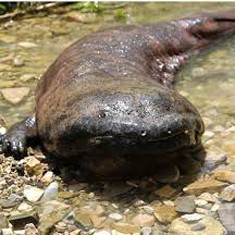 A combination of demand for rare aquatic species as well as government subsidies and propaganda is driving cultivation and consumption of Chinese giant salamanders in aquaculture bases across the country. The wild giant salamander has become a protected species in China after over-consumption for fine dining but cultivators have been stepping in to meet demand.
A combination of demand for rare aquatic species as well as government subsidies and propaganda is driving cultivation and consumption of Chinese giant salamanders in aquaculture bases across the country. The wild giant salamander has become a protected species in China after over-consumption for fine dining but cultivators have been stepping in to meet demand.China National Radio recently featured the efforts of officials in Jishou city (in central Hunan province) who have organized seven “professional culturing communities” with more than 300 families and 400 aquaculture companies, among them 100 companies culturing salamander (as well as “snake, black pig, salmon and other rare species”). Jishou claims to be making RMB 247.7 million (USD 40.3 million, EUR 30.6 million) from the “rare species” cultivation drive, with fishery contributing RMB 24.65 million (USD 4 million, EUR 3 million). “The culturing of rare species is developing fast,” an official told CNR broadcasters.
As is often the case, government subsidies — frequently offered as a way of lifting rural incomes — have driven aquaculture output. In southerly Guizhou province authorities in Congjiang county in 2013 earmarked RMB 1 million (USD 162,763, EUR 123,567) to build an 800-square meter pond and a 400-square meter in-house culturing pond for salamanders. Also in Guizhou, authorities in Meitan County in Guizhou province invested RMB 25 million (USD 4.1 million, EUR 3.1 million) to build a 7,000-square meter culturing salamander base which has already signed selling-contracts with 10 restaurants in Zunyi, according to local government.
A similar government-led drive in the Xuan’en region of water-rich central province of Hubei has led to a salamander glut, according to the local daily, Enshi Daily News. The newspaper claims prices have fallen sharply from RMB 3,000 (USD 488, EUR 370) per 500g to RMB 400 (USD 65, EUR 49) per 500g currently. “Lots of salamander farmers in Xuan’en suffered great loss. Local farmers blame a glut in supply and a lack of marketing channels for the slump in prices. Yet others see lower prices as a chance to stock up on more, cheaper fry for future production.”
The role of local government in the industry is emblematic of much of China’s aquaculture and agricultural sector, with the Communist Party government using its financial and media monopoly to promote output. In promoting local salmanders in provincial restaurants, authorities in Xuan’en claim the region has enough water and “unique geographical conditions” for salamander cultivation. They point to 121 rivers in Xuan’en which all have live salamander — one fifth of China’s total salamander population.
Upbeat reportage in China’s local press — often directed by government — has spurred others into the business around the country. The Chongqing View newspaper in southwesterly Sichuan province quoted a former industrial worker called Tian’gang who, in 2010, “found that as a national protected animal, Giant Salamander has a great market… after searching and comparing, Tian’gang found a place in A Peng Jiang river as the culture base for giant salamander… he invested more than RMB 600,000 (USD 97,674, EUR 74,158) on buying the relevant equipment and built 40 2-square-meter-sized ponds, after that he bought 300 giant salamander fries by using RMB 1 million (USD 162,763, EUR 123,567) from Xuan’en and Youyang in Hubei province.”
According to the Chongqing View by the end of 2011 Tian had 500 salamander worth RMB 3 million (USD 488,373, EUR 370,792) and hopes to have RMB 10 million (USD 1.6 million, EUR 1.2 million) worth of salamander by the end of 2014.





